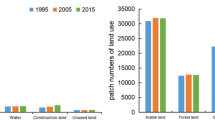Abstract
Taking Niyang River Basin as an example, applying with the indices of landscape pattern, the indices of ecological risk of ecosystems are calculated in this paper, which takes the value of ecological loss of main ecosystem as the evaluation standard and takes into account the impacts of probability or the velocity of main hazards and event of the ecosystem. And the grades of ecological risk are assessed. According to the results of assessment, the ecological risk grades of the basin are divided into five classes. From the first grade risk to the fifth grade risk, the values of regional risk indices gradually reduce. The first grade risk areas mainly distribute in Niyang river and its branches downstream and the surrounding areas of main towns. And the basin area of non-valley region and the headstream regions of the branches are the fifth grades risk areas. This evaluation results provide the basis to the regional sustainable development.
Similar content being viewed by others
References
Cao Hongfa, Shen Yingwa. Summarization of Study on Ecological Risk Assessment [J].Environmental Chemistry, 1991,10(3):26–30.
Louks O L. Looking for Surprise in Managing Stressed Ecosystems [J].Bioscience, 1985,35:428–432.
Kelly J R, Levin S A. A Comparison of Aquatic and Terrestrial Nutrient Cycling and Production Processes in Natural Ecosystems, with Reference to Ecological Concepts of Relevance to Some Waste Disposal Issues[C]//The Role of the Oceans as a Waste Disposal Option. MA, Hingham: Reidel Publish Company, 1986:165–203.
Yin Haowen. Program for Aquatic Environmental Ecological Risk Assessment [J].Shanghai Environmental Sciences, 1995,14(11):11–14 (Ch).
Fu Zaiyi, Xu Xuegong. Regional Ecological Risk Assessment [J].Advance in Earth Sciences, 2001,16(2):267–271 (Ch).
Han Yusheng, Zhang Mingtao.Integrated Programming of Resources Exploitation and Economic Development of Niyanghe Basin in Tibet [M]. Beijing: Science Press, 1993:73–74 (Ch).
The Integrated Survey Team of the Qinghai-Tibet Plateau of Chinese Academy of Sciences.The Physiognomy in Tibet [M]. Beijing: Science Press, 1983;21–151 (Ch).
The Integrated Survey Team of the Qinghai-Tibet Plateau of Chinese Academy of Sciences.The Climate of Tibet [M]. Beijing: Science Press, 1984:18–67 (Ch).
The Integrated Survey Team of the Qinghai-Tibet Plateau of Chinese Academy of Sciences.The Vegetation in Tibet [M]. Beijing: Science Press, 1988;150–295 (Ch).
The Integrated Survey Team of the Qinghai-Tibet Plateau of Chinese Academy of Sciences.The Rivers and Lakes in Tibet [M]. Beijing: Science Press, 1984:51–110 (Ch).
The Statistics Bureau of Tibet Autonomic Region Statistics.Annual of Tibet Autonomic Region in 2002 [M]. Beijing: Statistics Publishing Company of China, 2003 (Ch).
Wang Genxu, Cheng Guodong, Qian Ju The Problems of Analyses on Evaluation of Ecological Security [J].Chinese Journal of Applied Ecology, 2003,14(9):1551–1556 (Ch).
Fu Zaiyi, Xu Xuegong. Regional Ecological Risk Assessment in the Liaohe River Delta wetland [J].Acta Ecologica Sinica, 2001,21(3):365–367 (Ch).
Kong Hongmei, Zhao Jingzhu, Ji Lanzhu. Appraisement Measure of Ecological health [J].Chinese Journal of Applied Ecology, 2002,13(4): 486–490 (Ch).
Xiao Jingfeng, Ou Yanghua. Evaluation Indices and Measures of Ecological Health [J].Journal of Natural Resources 2002,17(2):203–209.
Xiao Duning, Hu Yuanman.Researches on Landscape Ecology of Surround BoHai Delta Wetlad [M]. Beijing: Science Press, 2001:275–300.
He Xiaorong.Study of the Landscape Patterns and Evaluation of the Ecological Risk on the Basin of the Qinghai-Tibet Plateaus—A Case Study on Niyang River Basin [D]. Chengdu: Institute of Mountain Hazard and Environment, Chinese Acadency of Sciences, 2005 (Ch).
Author information
Authors and Affiliations
Corresponding author
Additional information
Foundation item: Supported by the Research of the Alarm System in Advance on Eco-environmental Fragility, Ecological Security Strategy in Tibet(2004CCAO3600); Ecological Foundation Division Research of Tibet Autonomous Region (2001–2002)
Biography: HE Xiaorong (1970-), female, Ph. D., research direction: environmental degradation and ecosystem rebuilding.
Rights and permissions
About this article
Cite this article
Xiaorong, H., Xianghao, Z. & Xinwu, C. Analysis on landscape ecological risk of the Qinghai-Tibet Plateaus: A case study on Niyang River Basin. Wuhan Univ. J. Nat. Sci. 11, 977–983 (2006). https://doi.org/10.1007/BF02830197
Received:
Issue Date:
DOI: https://doi.org/10.1007/BF02830197
Key words
- the Qinghai-Tibet, Plateau
- Niyang River Basin
- ecological risk
- indices of ecological risk
- the value of ecological loss
- disaster




